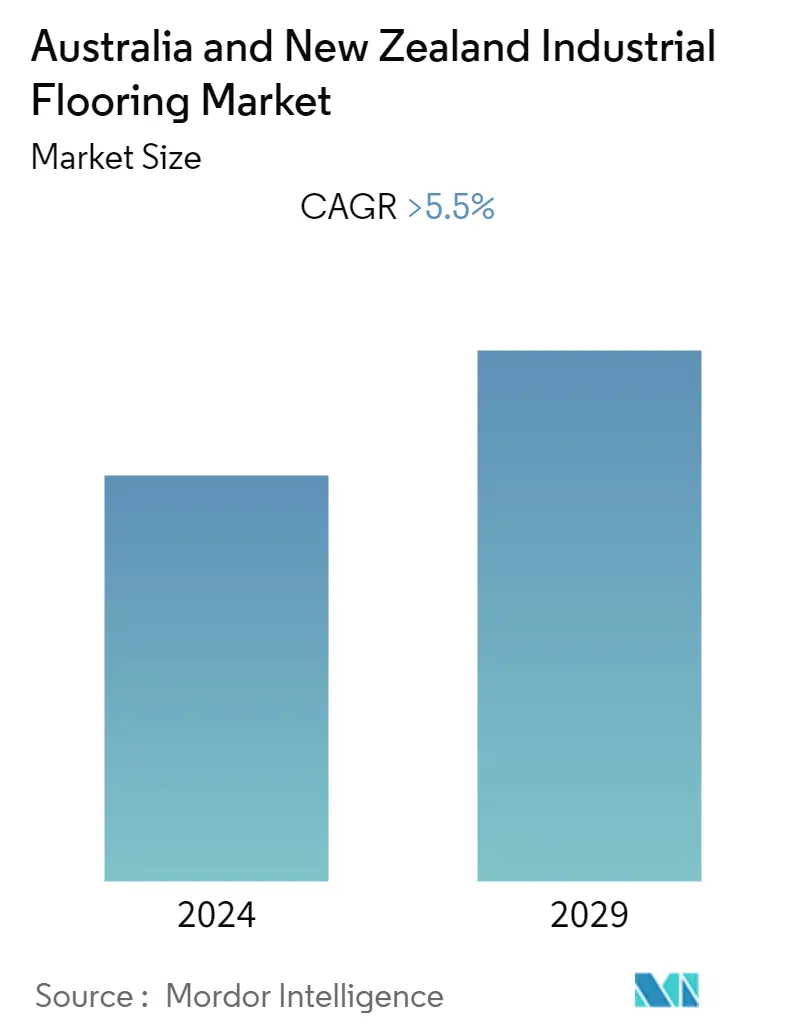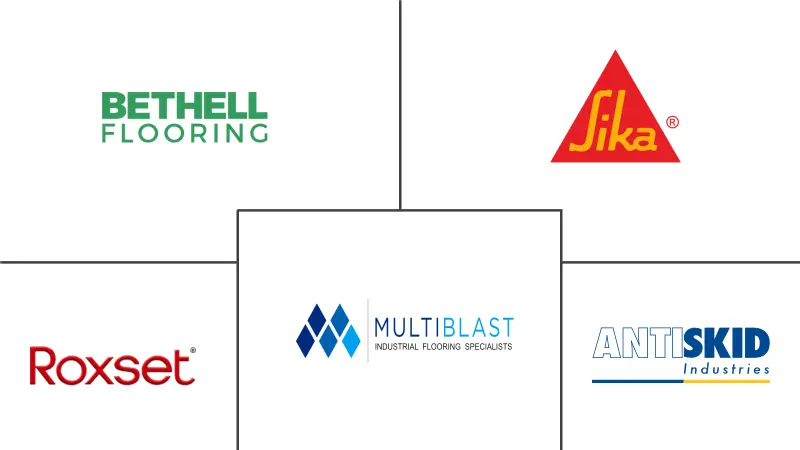
| Study Period | 2019 - 2029 |
| Base Year For Estimation | 2023 |
| Forecast Data Period | 2024 - 2029 |
| Historical Data Period | 2019 - 2022 |
| CAGR | 5.50 % |
| Market Concentration | Low |
Major Players
*Disclaimer: Major Players sorted in no particular order |
Australia & New Zealand Industrial Flooring Market Analysis
The Australia and New Zealand industrial flooring market is projected to register a CAGR of more than 5.5% during the forecast period.
- COVID-19 negatively impacted the market in 2020. The building and construction industry came to a standstill owing to the unavailability of raw materials, shortage of laborers, and disruption in the supply chain. However, the market reached pre-pandemic levels in 2022 and is expected to grow steadily in the future. The upsurge in demand for industrial flooring in the food and beverage industry has propelled market growth.
- Over the medium term, the growth of the industrial flooring market is likely driven by the growing awareness about the advantages of industrial flooring. Industrial floorings, which have gradually changed from conventional cement flooring tiles to dust-free monolithic floors, play a vital role in productivity, safety, and housekeeping.
- There are different types of industrial flooring, including polyurethane (PU) flooring, polyethylene (PE) foam flooring, and epoxy flooring. They provide excellent pavements in strength, thickness, flexibility, washability, aesthetics, resistance to toxic and corrosive chemicals, mechanical abrasion, static, and microbial outgrowth, among many other factors.
- Fluctuating raw materials and high product prices will likely hamper the industrial flooring market growth. The emerging application of industrial flooring in the healthcare industry is expected to offer new opportunities for overall industry growth.
Australia & New Zealand Industrial Flooring Industry Segmentation
The term industrial floor indicates the seamless concrete floors used in the industrial field. A traditional industrial concrete floor offers several features, such as durability and resistance to abrasion, heavy traffic, and heavy loads, but its aesthetic look is not alluring.
The Australia and New Zealand industrial flooring market is segmented by resin type, application, and end-user industry. By flooring material, the market is segmented into epoxy, polyaspartic, polyurethane, acrylic, and other resin types. By application, the market is segmented into concrete, wood, and other applications. By end-user industry, the market is segmented into food and beverage, chemical, transportation and aviation, healthcare, and other end-user industries.
For each segment, the market sizing and forecasts have been done on the basis of revenue (USD million).
| Epoxy |
| Polyaspartic |
| Polyurethane |
| Acrylic |
| Other Resin Types |
| Concrete |
| Wood |
| Other Applications |
| Food and Beverage |
| Chemical |
| Transportation and Aviation |
| Healthcare |
| Other End-User Industries |
Australia and New Zealand Industrial Flooring Market Size Summary
The industrial flooring market in Australia and New Zealand is poised for significant growth, driven by increasing demand across various sectors, particularly in food and beverage. The market, which experienced setbacks due to the COVID-19 pandemic, has rebounded to pre-pandemic levels and is expected to continue its upward trajectory. The shift from traditional cement flooring to advanced solutions like polyurethane, polyethylene foam, and epoxy flooring is enhancing productivity, safety, and maintenance. These flooring types offer numerous benefits, including resistance to chemicals, abrasion, and microbial growth, making them ideal for industrial applications. Despite challenges such as fluctuating raw material costs and high product prices, the market is set to expand, with emerging opportunities in the healthcare sector further bolstering growth.
Epoxy flooring, in particular, is gaining traction due to its durability and protective qualities, making it suitable for high-traffic areas and environments exposed to harsh conditions. The food and beverage industry, with its stringent hygiene and safety standards, is a major driver of industrial flooring adoption, as these floors meet the necessary requirements for spill resistance and easy maintenance. The ongoing construction activities in the region, coupled with the rising demand for plant-based and low-alcohol beverages, are expected to further increase the demand for industrial flooring solutions. The market is characterized by fragmentation, with key players like Antiskid Industries, Multiblast Flooring Pty Ltd., Roxset Australia, Sika Australia, and Bethell Flooring leading the charge in providing innovative flooring solutions.
Australia and New Zealand Industrial Flooring Market Size - Table of Contents
1. MARKET DYNAMICS
-
1.1 Drivers
- 1.1.1 Increasing Demand from the Food and Beverage Industry
- 1.1.2 Growing Application in Chemical Industry
-
1.2 Restraints
- 1.2.1 Fluctuating Prices of Raw Material
- 1.2.2 High Product Prices
- 1.3 Industry Value Chain Analysis
-
1.4 Porter's Five Forces Analysis
- 1.4.1 Bargaining Power of Suppliers
- 1.4.2 Bargaining Power of Consumers
- 1.4.3 Threat of New Entrants
- 1.4.4 Threat of Substitute Products and Services
- 1.4.5 Degree of Competition
2. MARKET SEGMENTATION (Market Size in Value)
-
2.1 Resin Type
- 2.1.1 Epoxy
- 2.1.2 Polyaspartic
- 2.1.3 Polyurethane
- 2.1.4 Acrylic
- 2.1.5 Other Resin Types
-
2.2 Application
- 2.2.1 Concrete
- 2.2.2 Wood
- 2.2.3 Other Applications
-
2.3 End-User Industry
- 2.3.1 Food and Beverage
- 2.3.2 Chemical
- 2.3.3 Transportation and Aviation
- 2.3.4 Healthcare
- 2.3.5 Other End-User Industries
Australia & New Zealand Industrial Flooring Market Research FAQs
What is the current Australia and New Zealand Industrial Flooring Market size?
The Australia and New Zealand Industrial Flooring Market is projected to register a CAGR of greater than 5.5% during the forecast period (2024-2029)
Who are the key players in Australia and New Zealand Industrial Flooring Market?
Roxset Australia, ANTISKID INDUSTRIES, Sika Australia, Bethell Flooring and Multiblast Flooring Pty Ltd are the major companies operating in the Australia and New Zealand Industrial Flooring Market.


